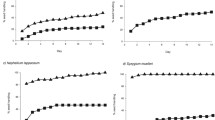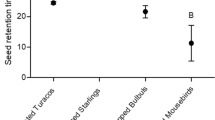Abstract
Large-scale rodent control can help to manage endangered species that are vulnerable to invasive rodent consumption. A 26 ha rodent snap-trap grid was installed in montane forest on Oahu Island, Hawaii, in order to protect endangered snails and plants. To assess the effectiveness of this trapping operation in reducing fruit consumption and seed predation of the endangered Hawaiian lobeliad, Cyanea superba subsp. superba, pre- and post-dispersal C. superba fruit consumption were monitored for 36 plants at the site with rodent control (Kahanahaiki) and 42 plants at an adjacent site without rodent control (Pahole). Over 47 % of all monitored fruit were eaten on the plants at Pahole compared to 4 % at Kahanahaiki. Images captured using motion-sensing cameras suggest that black rats (Rattus rattus) were the only pre-dispersal fruit consumers. To quantify post-dispersal fruit consumption, and to identify the culprit frugivore(s), mature fruit were placed in tracking tunnels positioned on the forest floor and checked daily. At Pahole, all of the fruit were consumed by rats compared to 29 % at Kahanahaiki. Lastly, to determine if rodents from the sites were predators or dispersers of C. superba seed, fruit were fed to captive black rats and house mice (Mus musculus). Black rats consumed entire fruit, killing all the seed, while mice did little damage to the fruit and seed. Therefore, large-scale rat trapping can directly benefit the reproduction of C. superba subsp. superba. Controlling black rats at restoration sites appears integral to the successful restoration of this endangered plant species.





Similar content being viewed by others
References
Angel A, Wanless RM, Cooper J (2009) Review of impacts of the introduced house mouse on islands in the Southern Ocean: are mice equivalent to rats? Biol Invasions 11:1743–1754
Athens JS, Tuggle HD, Ward JV, Welch DJ (2002) Avifaunal extinctions, vegetation change, and polynesian impacts in prehistoric Hawai’i. Archaeol Ocean 37:57–78
Atkinson IAE (1977) A reassessment of factors, particularly Rattus rattus L., that influenced the decline of endemic forest birds in the Hawaiian Islands. Pac Sci 31:109–133
Atkinson IAE (1985) The spread of commensal species of Rattus to oceanic islands and their effects on avifaunas. In: Moors PJ (ed) Conservation of Island birds. ICBP Technical Publication, Cambridge, pp 35–81
Auld TD, Hutton I, Ooi MKJ, Denham AJ (2010) Disruption of recruitment in two endemic palms on Lord Howe Island by invasive rats. Biol Invasions 12:3351–3361
Campbell DJ, Atkinson IAE (1999) Effects of kiore (Rattus exulans Peale) on recruitment of indigenous coastal trees on northern offshore islands of New Zealand. J Roy Soc NZ 29:265–290
Campbell DJ, Atkinson IAE (2002) Depression of tree recruitment by the Pacific rat (Rattus exulans Peale) on New Zealand’s northern offshore islands. Biol Conserv 109:19–35
Chimera CG, Drake DR (2010) Patterns of seed dispersal and dispersal failure in a Hawaiian dry forest having only introduced birds. Biotropica 42:493–502
Chimera CG, Drake DR (2011) Could poor seed dispersal contribute to predation by introduced rodents in a Hawaiian dry forest? Biol Invasions 13:1029–1042
Cole FR, Loope LL, Medeiros AC, Howe CE, Anderson LJ (2000) Food habits of introduced rodents in high-elevation shrubland of Haleakala National Park, Maui, Hawaii. Pac Sci 54:313–329
Cuddihy LW, Stone CP (1990) Alteration of native Hawaiian vegetation: effects of humans, their activities and introductions. University of Hawaii Press, Honolulu, Hawaii
Delgado Garcia JD (2002) Interaction between introduced rats and a frugivore bird-plant system in a relict island forest. J Nat Hist 36:1247–1258
Foster JT, Robinson SK (2007) Introduced birds and the fate of the Hawaiian rainforests. Conserv Biol 21:1248–1257
Fukami T, Wardle DA, Bellingham PJ, Mulder CPH, Towns DR, Yeates GW, Bonner KI, Durrett MS, Grant-Hoffman MN, Williamson WM (2006) Above- and below-ground impacts of introduced predators in seabird-dominated island ecosystems. Ecol Lett 9:1299–1307
Grant-Hoffman MN, Barboza PS (2010) Herbivory in invasive rats: criteria for food selection. Biol Invasions 12:805–825
Grant-Hoffman MN, Mulder CPH, Bellingham PJ (2010a) Effects of invasive rats and burrowing seabirds on seeds and seedlings on New Zealand islands. Oecologia 162:1005–1016
Grant-Hoffman MN, Mulder CPH, Bellingham PJ (2010b) Invasive rats alter woody seedling composition on seabird-dominated islands in New Zealand. Oecologia 163:449–460
Howald G, Donlan CJ, Galvan JP, Russell JC, Parkes J, Samaniego A, Wang Y, Veitch D, Genovesi P, Pascual M, Saunders A, Tershy B (2007) Invasive rodent eradication on islands. Conserv Biol 21:1258–1268
Joe SM, Daehler CC (2008) Invasive slugs as under-appreciated obstacles to rare plant restoration: evidence from the Hawaiian Islands. Biol Invasions 10:245–255
King CM, Innes JG, Gleeson D, Fitzgerald N, Winstanley T, O’Brien B, Bridgman L, Cox N (2011) Reinvasion by ship rats (Rattus rattus) of forest fragments after eradication. Biol Invasions 13:2391–2408
Lindsey GD, Mosher SM, Fancy SG, Smucker TD (1999) Population structure and movements of introduced rats in an Hawaiian rainforest. Pac Conserv Biol 5:94–102
MacAvoy SE, Arneson LS, Bassett E (2006) Correlation of metabolism with tissue carbon and nitrogen turnover rate in small mammals. Oecologia 150:190–201
McConkey KR, Drake DR, Meehan HJ, Parsons N (2003) Husking stations provide evidence of seed predation by introduced rodents in Tongan rain forests. Biol Conserv 109:221–225
Meyer J-Y, Butaud J-F (2009) The impacts of rats on the endangered native flora of French Polynesia (Pacific Islands): drivers of plant extinction or coup de grâce species? Biol Invasions 11:1569–1585
Moles AT, Drake DR (1999) Post-dispersal seed predation on eleven large-seeded species from the New Zealand flora: a preliminary study in secondary forest. NZJ Bot 37:679–685
Mulder CPH, Grant-Hoffman MN, Towns DR, Bellingham PJ, Wardle DA, Durrett MS, Fukami T, Bonner KI (2009) Direct and indirect effects of rats: does rat eradication restore ecosystem functioning of New Zealand seabird islands? Biol Invasions 11:1671–1688
NZ DOC (New Zealand Department of Conservation) (2007) Kill trapping for rat control (Current agreed best practice). Department of Conservation, Wellington, NZ. (http://www.predatortraps.com/downloads/techniques_rat_trap.doc)
OANRP (2009) 2009 status report for the Makua and Oahu implementation plans, Oahu Army Natural Resources Program. OANRP, Oahu, Hawaii
Pérez HE, Shiels AB, Zaleski HM, Drake DR (2008) Germination after simulated rat damage in seeds of two endemic Hawaiian palm species. J Trop Ecol 24:555–558
R Development Core Team (2010) R: a language and environment for statistical computing. The R Foundation for Statistical Computing, Vienna
Ruscoe WA, Murphy EC (2005) House Mouse. In: King CM (ed) The handbook of New Zealand mammals, 2nd edn. Oxford University Press, Melbourne, pp 204–221
Salvande M, Mulet M, Gómez González LA (2006) Ilex canariensis Poir. (Aquifoliaceae) post-dispersal seed predation in the Canary Islands. Plant Ecol 187:143–151
Saunders A, Norton DA (2001) Ecological restoration at Mainland Islands in New Zealand. Biol Conserv 99:109–119
Shiels AB (2010) Ecology and impacts of introduced rodents (Rattus spp. and Mus musculus) in the Hawaiian Islands. Dissertation, Department of Botany, University of Hawaii at Manoa
Shiels AB (2011) Frugivory by introduced black rats (Rattus rattus) promotes dispersal of invasive plant seeds. Biol Invasions 13:781–792
Shiels AB, Drake DR (2011) Are introduced rats (Rattus rattus) both seed predators and dispersers in Hawaii? Biol Invasions 13:883–894
Sugihara RT (1997) Abundance and diets of rats in two Hawaiian forests. Pac Sci 51:189–198
Tomich PQ (1969) Mammals in Hawaii. Bernice P. Bishop Museum Special Publication 57:32–42
Towns DR, Broome KG (2003) From small Maria to massive Campbell: 40 years of rat eradications from New Zealand islands. N Z J Zool 30:377–398
Towns DR, Atkinson IAE, Daugherty CH (2006) Have the harmful effects of introduced rats on islands been exaggerated? Biol Invasions 8:863–891
USFWS (1998) Recovery plan for the Oahu plants. US Fish and Wildlife Service, Portland, Oregon, p 199
USFWS (2007) Five year review, summary and evaluation of the recovery plan for Cyanea superba (haha). US Fish and Wildlife Service. Pacific Islands Fish and Wildlife Office, Honolulu, Hawaii
Wagner WL, Herbst DR, Sohmer SH (1999) Manual of the flowering plants of Hawaii, vol 1 and 2, Revised edn. University of Hawaii Press, Honolulu
Williams PA, Karl BJ, Bannister P, Lee WG (2000) Small mammals as potential seed dispersers in New Zealand. Austral Ecol 25:523–532
Wilmshurst JM, Hunt TL, Lipo CP, Anderson AJ (2011) High-precision radiocarbon dating shows recent and rapid initial human colonization of East Polynesia. Proc Natl Acad Sci 108:1815–1820
Acknowledgments
We thank the Oahu Army Natural Resources Program (OANRP) for funding and logistical support of this project—we are especially grateful for the many staff members that helped with the intensive and on-going rodent trapping at Kahanahaiki. We thank both OANRP and the Pahole Natural Area Reserve managers (State of Hawaii) for land access, and Don Drake, Kapua Kawelo, Matthew Keir, Clifford Morden, Julia Rowe, Lauren Weisenberger, and two anonymous reviewers for their helpful comments on an earlier draft of this manuscript. RJP and ABS wish to thank the Pacific Cooperative Studies Unit and Clifford Morden for providing logistical support. RJP gratefully acknowledges the financial support provided by Fulbright New Zealand and the John R. Templin Scholarship. This research was approved by the University of Hawaii Animal Use and Care Committee.
Author information
Authors and Affiliations
Corresponding author
Rights and permissions
About this article
Cite this article
Pender, R.J., Shiels, A.B., Bialic-Murphy, L. et al. Large-scale rodent control reduces pre- and post-dispersal seed predation of the endangered Hawaiian lobeliad, Cyanea superba subsp. superba (Campanulaceae). Biol Invasions 15, 213–223 (2013). https://doi.org/10.1007/s10530-012-0280-3
Received:
Accepted:
Published:
Issue Date:
DOI: https://doi.org/10.1007/s10530-012-0280-3




